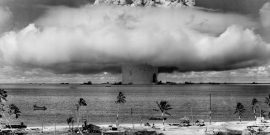An Amazon show that offers a glimpse into the nature of our recent wars—shadowy, ambiguous, and fraught with tension—and asks: What should we remember?
Have We Seen the End of War?
In 2011, Steven Pinker published an instant bestseller, The Better Angels of Our Nature: Why Violence Has Declined, which runs nearly 700 pages (not including notes and references). Bill Gates called it “the most inspiring book I’ve ever read,” and it appeared in Mark Zuckerberg’s 2015 book club. Pinker, the Johnstone Family Professor of Psychology at Harvard University, thereby built on an argument that had been starting to circulate among political scientists—namely, that war has been in decline for decades, perhaps centuries. As the title of his book suggests, however, Pinker broadened this to speak about trends in violence more generally. Bear Braumoeller, a Professor in the Department of Political Science at The Ohio State University, focuses on the decline-of-war thesis and takes just over 200 pages to refute it. In Only the Dead: The Persistence of War in the Modern Age, Braumoeller persuasively argues that war is not in decline and that the best tool we have to prevent war—international orders “like the Concert of Europe and the postwar Western liberal order”—will never eradicate war because they make conflict with those outside the orders more likely.
It is important to reiterate the distinction between violence and war at the outset. Pinker’s claim that war is in decline is part of a broader argument that violence is in decline. I need not describe Pinker’s argument in full here because Braumoeller focuses more narrowly on war. As Braumoeller describes it, “Professor Steven Pinker argues that there has been a gradual decline in violence in general over the course of millennia, that the deadliness of international conflict has decreased since 1945, and that we now live in what is arguably the most peaceful period in history.” Braumoeller takes Pinker’s claims about international conflict as his point of entry into this debate.
After introducing his argument and its foils, Braumoeller spends the second and third chapters outlining reasons to be skeptical of the decline-of-war thesis. Among other things, Pinker rather selectively utilizes data that support his argument, and he and other proponents of the thesis do not adequately incorporate the role of chance in their arguments. Braumoeller offers a striking example of this: “The Long Peace [following World War II] is only slightly less likely to have happened by chance than the two World Wars.” Similarly, public opinion surveys provide no clear evidence that support for war is declining around the world, nor do trends in battle-related deaths, which often fail to account for increased populations, smaller militaries, and chances of escalation. Braumoeller is especially emphatic on the unconvincing argument that, as Pinker would have it, the spread of “Renaissance humanism and empathy” is driving a decline in war. Braumoeller draws in part on the work of anthropologists, historians, and philosophers to demonstrate that the Enlightenment produced a plethora of ideas, many of which were not plausibly pacifying, and that wars have often been fought to further someone’s vision of a more enlightened world.
For all of the above reasons, Braumoeller thinks that we ought to be skeptical of the decline-of-war-thesis. In the next three chapters, he conducts an exhaustive set of statistical tests to show that this thesis deserves more than skepticism—the data demand rejection. The results are quite stark. No matter how you operationalize “war,” we do not see a decline over the past two centuries (many data sets extend only to 1815). Rather, we see an increase in the overall rate of international war initiation over that time period. Moreover, on the question of whether wars are getting less deadly, Braumoeller concludes that the nature of the statistical distribution of war intensity offers little reason for optimism. “[T]he outcomes of wars are consistent with a process in which the only difference between a small war and a very large one is random chance.”
The last question Braumoeller tackles in this section is whether the causes of war are themselves in decline. There is a voluminous literature on the determinants of war and peace—trade, regime type, and the distribution of power are just a few possible explanations—and across all the plausible variables, there is no discernible trend that would indicate a decline in the causes of war. All of this is clearly explained, and there is a more granular appendix for those interested in sifting further through the data.
In short, Braumoeller examines the decline-of-war thesis and finds that the evidence we have does not support it. A rigorous examination of the deadliness of war, the potency of the causes of war, and the rates of conflict initiation ultimately tells a tale that contradicts Steven Pinker’s narrative that war is on the decline. Perhaps most troublingly, as Braumoeller’s colleague Professor Jennifer Mitzen noted in an early review of Pinker’s book, the widespread acceptance of Pinker’s thesis could yield complacence about the efforts necessary to avoid war.
The decline-of-war thesis does not get it quite right. But even if we cannot reliably detect a long-term tendency toward peace, Braumoeller acknowledges that there are occasional trends in the data to suggest that at least some parts of the world occasionally become less prone to war—“islands of peace,” he calls them. What makes these islands more pacific, he argues, is international order. That is, from time to time, states form “multilateral security regimes that involve one or more major powers and are legitimated by a set of principles that are potentially universal in scope.” These orders, however, simultaneously decrease the probability of conflict between member states and increase the probability of external conflict. Thus, for example, the Concert of Europe dampened conflict among its members while making them more willing to wage war against revolutionaries. Braumoeller charts the rise and fall of such orders through 19th-century Europe, the interwar period, the Cold War, and the post-Cold War period, and he concludes this section with a brief statistical analysis. When you calculate the rate of conflict initiation within and across the boundaries of these orders, you see significantly more conflict across them. Where a single order prevailed—as in the Concert of Europe and the post-Cold War period—you see the most peace.
The liberal international order and its health have recently become the subject of much academic and political attention, so I suspect that this is where readers will be inclined to question Braumoeller most spiritedly. The point I would raise here is a point that other International Relations scholars have raised in earlier debates. The conclusion that the world is most peaceful where a single order prevails is reminiscent of several earlier scholarly arguments: the international system would be most peaceful with a single great power; war occurs because there is no single higher authority that can reliably and legitimately adjudicate disputes between states; war would not occur if states all shared the same regime type (i.e., liberal democracy). Others have asked about the implications of such arguments. Should we work toward a world state, toward a world in which one state is perpetually more powerful than all others, or toward perpetual peace by way of global democratization? Even if their own theories would suggest that some such homogenizing force would be a net positive for world peace, IR scholars rarely advocate for such things given their suspicions that such outcomes would be impossible or immorally violent to attain. I will ask the question of Braumoeller’s thesis—if a single truly global order would reduce the chances of war, is that something we should seek?
All told, this is a careful piece of scholarship that is admirably accessible. It is not, however, a book that tells us everything is fine. If the book does not, therefore, receive any praise from Bill Gates or Mark Zuckerberg, that is entirely to Braumoeller’s credit.



